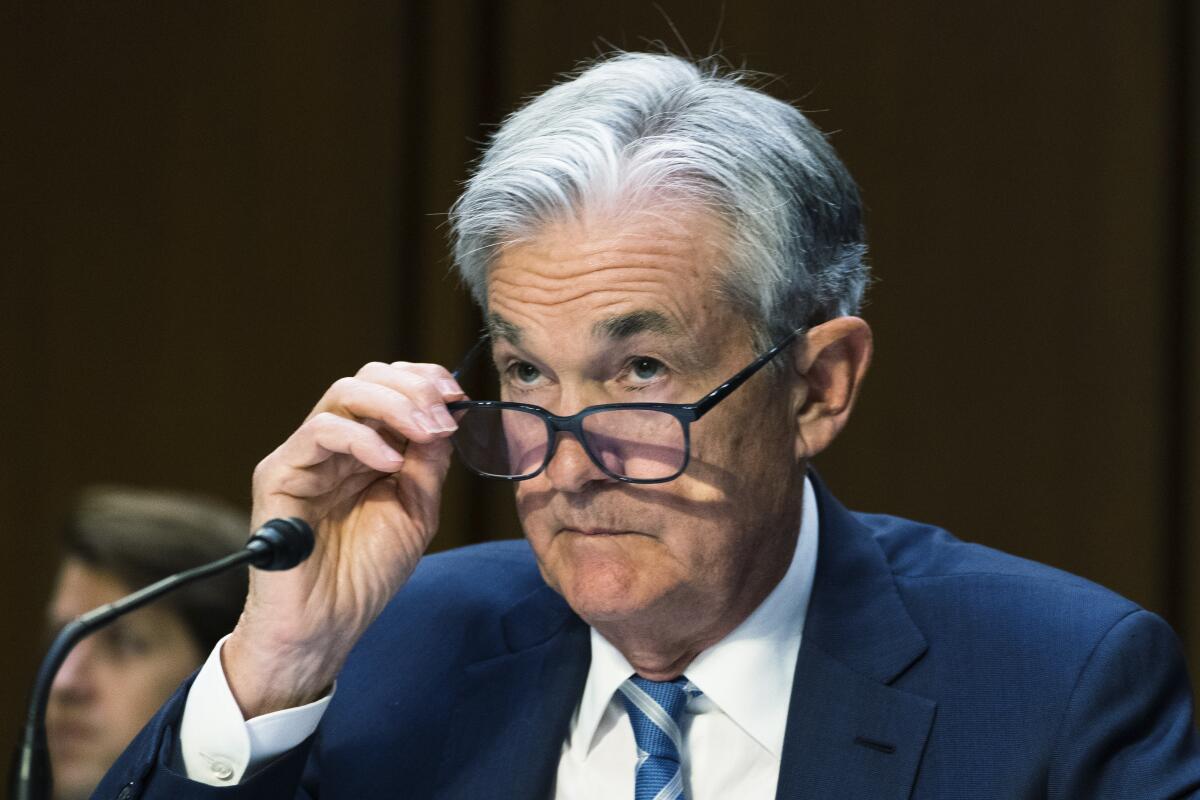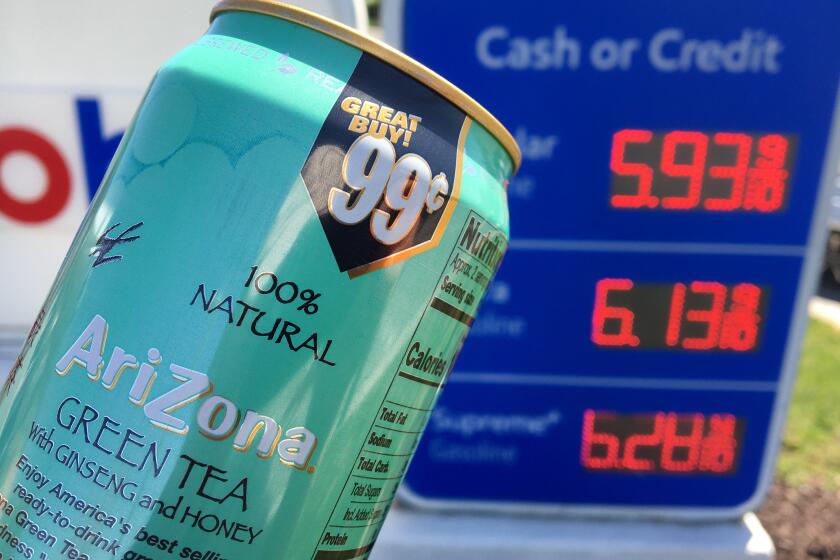Recession is possible but ‘not our intended outcome,’ Powell tells skeptical Senate panel

- Share via
WASHINGTON — Federal Reserve Chair Jerome H. Powell sought Wednesday to reassure the public that the central bank will raise interest rates high and fast enough to quell inflation, without tightening credit so much as to throttle the economy and cause a recession.
Testifying before the Senate Banking Committee, Powell faced skeptical questions from members of both parties about the Fed’s ability to tame inflation, which has surged to the top of Americans’ concerns as congressional elections near.
Democrats wondered whether the Fed’s accelerated rate increases will succeed in curbing inflation or might instead just tip the economy into a downturn. Several Republicans charged that the Powell Fed had moved too slowly to begin raising rates and now must speed up its hikes.
Powell acknowledged that a recession is possible as the Fed pushes borrowing costs steadily higher.
“It’s certainly a possibility,” he said in response to a question from Sen. John Tester, a Democrat from Montana. “It’s not our intended outcome, but it’s certainly a possibility.”
Powell emphasized that the Fed’s primary goal is to reduce inflation but said he still hopes to achieve a “soft landing” — a reduction in inflation and a slowdown in growth without triggering a recession and high unemployment.
“We do think it’s absolutely essential that we restore price stability, really for the benefit of the labor market as much as anything else,” Powell said on the first of two days of testimony as part of the Fed’s semiannual report to Congress.
He said the pace of future rate increases will depend on whether — and how quickly — inflation starts to decline, something the Fed will assess on a “meeting by meeting” basis.
The central bank’s accelerating rate increases — it started with a quarter-point hike in its key short-term rate in March, then a half-point increase in May, then three-quarters of a point last week — have alarmed investors and led to sharp declines in the financial markets.
Powell’s testimony comes exactly a week after the Fed announced its three-quarter-point increase, its biggest boost in nearly three decades, to a range of 1.5% to 1.75%. With inflation at a 40-year high, the Fed’s policymakers also forecast a more accelerated pace of rate increases this year and next than they had predicted three months ago, with its key rate reaching 3.8% by the end of 2023. That would be its highest level in 15 years.
Any downturn is likely to be mild because many consumers have a financial buffer and the labor market still has legs.
Concerns are growing that the Fed will end up tightening credit so much as to cause a recession. This week, Goldman Sachs estimated the likelihood of a recession at 30% over the next year and at 48% over the next two years.
A senior Republican on the Banking Committee, Sen. Thom Tillis of North Carolina, on Wednesday accused Powell of having taken too long to raise rates, saying that the Fed’s increases “are long overdue” and that its benchmark short-term rate should go much higher.
“The Fed has largely boxed itself into a menu of purely reactive policy measures,” Tillis said.
Tillis, like many Republicans, also blamed President Biden’s $1.9-trillion financial stimulus package, approved in March 2021, for being excessively large and exacerbating inflation. Many economists agree that the additional spending contributed to rising prices by magnifying demand even while supply chains were snarled by COVID-related shutdowns and labor shortages were driving up wages. Inflation pressures were further worsened by Russia’s invasion of Ukraine.
Biden on Wednesday called on Congress to suspend U.S. gas and diesel taxes for three months to reduce the sting of high pump prices, which are averaging nearly $5 a gallon. Many economists are skeptical that consumers would see the full benefit of a tax holiday on the 18.4-cent-a-gallon gas tax.
The public’s anxiety about inflation has weakened Biden’s approval ratings and raised the likelihood of Democratic losses in November. While taking some steps to try to ease the burden of inflation, the president has emphasized his belief that the ability to curb inflation rests mainly with the Fed.
At Wednesday’s hearing, Sen. Elizabeth Warren, a Democrat from Massachusetts, challenged Powell’s rate hike plans and asked whether they would reduce gas or food prices, some of the highest-profile drivers of inflation. Powell acknowledged that they wouldn’t.
Instead, Powell said that higher borrowing costs for things such as mortgages, auto loans and credit cards, resulting directly from the Fed’s increases, can help slow consumer demand and inflation pressures.
Tall cans of AriZona iced tea have cost 99 cents since 1992. The family behind the company says it’s committed to that price even as the prices of aluminum and corn syrup climb higher.
Yet Warren and other Democrats argued that the Fed’s approach carries the risk of weakening the economy and heightening unemployment even as the war in Ukraine keeps gas and food prices high. Such a dynamic would resemble the dreaded “stagflation” of the 1970s.
“You know what’s worse than high inflation with low unemployment?” she asked. “High inflation and a recession with millions of people out of work.”
“I hope you consider that before you drive the U.S. economy off a cliff,” Warren said.
Warren said that Biden’s efforts to fight inflation, such as trying to clear clogged supply chains and increasing the use of antitrust rules to break up monopolies, would more effectively fight higher prices.
At a news conference last week, Powell suggested that a rate increase of either half or three-quarters of a point will be considered at the Fed’s next meeting in late July. Either one would exceed the quarter-point Fed hikes that have been typical in the past, and they reflect the central bank’s struggle to curb high inflation as quickly as possible.
Anticipating additional large rate increases ahead, investors have sent Treasury yields sharply higher, raising borrowing costs for home purchases. With the average 30-year fixed mortgage rate up to roughly 5.8% — nearly twice the rate just a year ago — home sales have weakened. Credit card users and automobile buyers are also being hit with higher borrowing costs.
Powell also said Wednesday that the Fed isn’t yet seeing any signs that inflation is moderating in a meaningful way, even though some price measures, excluding gas and food, have slowed a bit in the last four months.
“We’re looking for that,” he said. “We’re not seeing it yet.”
More to Read
Inside the business of entertainment
The Wide Shot brings you news, analysis and insights on everything from streaming wars to production — and what it all means for the future.
You may occasionally receive promotional content from the Los Angeles Times.












